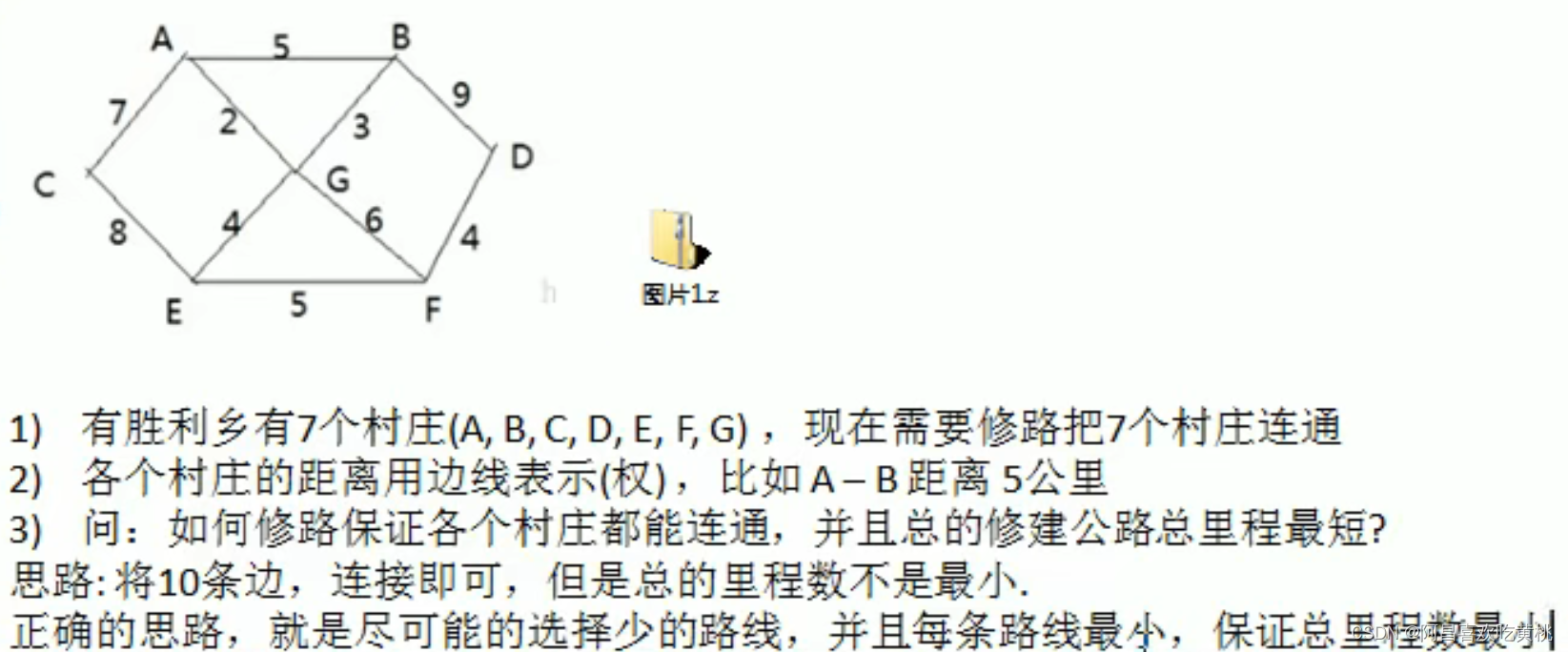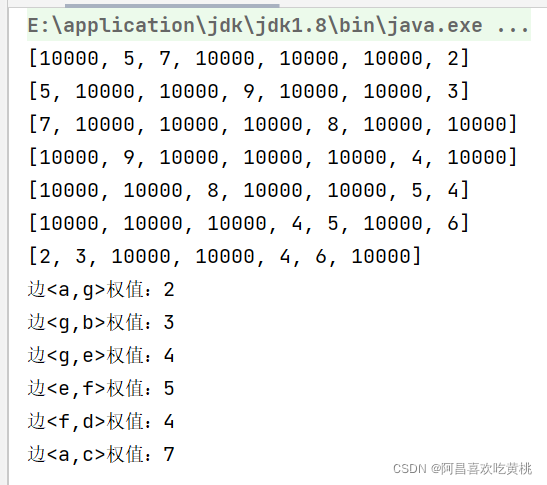普利姆算法
一、问题引出

二、最小生成树

三、普利姆算法介绍

四、图解分析

五、代码实现
package com.achang.algorithm;
import java.util.Arrays;
/**
* 普利姆算法
*/
public class PrimAlgorithm {
public static void main(String[] args) {
//初始化最小生成树
char[] data = {'a','b','c','d','e','f','g'};
//临界矩阵的关系,用10000表示不连通
int[][] weight = new int[][]{
//a,b,c,d,e,f,g
{10000,5,7,10000,10000,10000,2},//a
{5,10000,10000,9,10000,10000,3},//b
{7,10000,10000,10000,8,10000,10000},//c
{10000,9,10000,10000,10000,4,10000},//d
{10000,10000,8,10000,10000,5,4},//e
{10000,10000,10000,4,5,10000,6},//f
{2,3,10000,10000,4,6,10000},//g
};
Graph graph = new Graph(data.length);
MinTree minTree = new MinTree();
minTree.createGraph(graph,
data.length,
data,
weight);
minTree.list(graph);
//使用普利姆算法生成最小生成树
minTree.prim(graph,0);
}
}
//创建最小生成树,村庄图
class MinTree{
/**
* 创建图的临界矩阵
* @param graph 图对象
* @param verxs 图对应的节点个数
* @param data 图各个节点的值
* @param weight 图的临界矩阵
*/
public void createGraph(Graph graph,int verxs,char[] data,int[][] weight){
int i,j;
for (i = 0; i < verxs; i++) {
graph.data[i] = data[i];
for (j = 0; j < verxs;j++){
graph.weight[i][j] = weight[i][j];
}
}
}
//遍历图的临界矩阵
public void list(Graph graph){
for (int[] ints : graph.weight) {
System.out.println(Arrays.toString(ints));
}
}
/**
* 普利姆算法,得到最小生成树
* @param graph 图结构
* @param v 表示从图结构的第几个节点开始生成 'a'->0
* 'b'->1
* 'c'->2
* .....
*/
public void prim(Graph graph,int v){
//表示标记节点是否被访问过,元素值为0,表示没有被访问过
int[] visited = new int[graph.verxs];
visited[v] = 1;
//用h1、h2记录两个节点的下标
int h1 = -1;
int h2 = -1;
//初始化minWeight为一个大数,后面会被替换更改
int minWeight = 10000;
//因为有graph.verxs个节点,那普利姆算法结束后,有graph.verxs-1条边
//确定每一次生成的子图,和哪个节点和这次遍历节点的记录【权值】最近
for (int i = 1; i < graph.verxs; i++) {//i节点表示,被访问过的节点
for (int j = 0; j < graph.verxs; j++) {//j节点表示,还没有访问过的节点
for (int k = 0; k < graph.verxs; k++) {
if (visited[j]==1 && visited[k] == 0 && graph.weight[j][k] < minWeight){
//替换minWeight,寻找已经访问过的节点和未访问过的节点间,权值最小的边
minWeight = graph.weight[j][k];
//并记录此节点的下标
h1 = j;
h2 = k;
}
}
}
//退出了上面的for循环后就找到了这条边
System.out.println("边<"+graph.data[h1]+","+graph.data[h2]+">权值:"+minWeight);
//将当前节点,标记为已访问节点
visited[h2] = 1;
//重置minWeight
minWeight = 10000;
}
}
}
//图结构
class Graph{
int verxs;//图节点个数
char[] data;//保存节点的数据
int[][] weight;//存放边值,临界矩阵
public Graph(int size){
this.verxs = size;
data = new char[verxs];
weight = new int[verxs][verxs];
}
}

